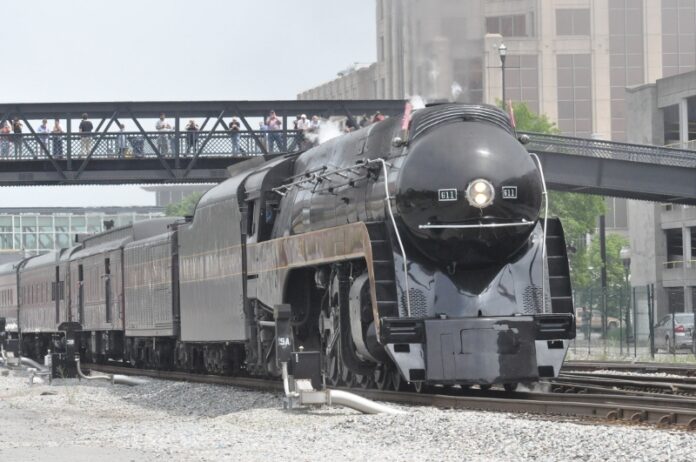
The “Spirit of Roanoke” was again rolling the rails last weekend from the O. Winston Link Museum in downtown Roanoke. In the second straight year of rail excursions, there’s little doubt that the popularity of the iconic J-Class locomotive hasn’t waned.
With capacity crowds filling most passenger cars from both the old Norfolk & Southern line along with other prominent railway lines from around the country, four classic trips brought out riders and onlookers Saturday and Sunday.
Morning trips both days went the round-trips of 98 miles on the Powhatan Arrow from Roanoke to Lynchburg, departing at 8 am and returning around noon. Upon reaching Lynchburg, the 611 reversed its direction with the use of a rail line “wye,” a triangular configuration in which a train can be turned around through a switch, thus leaving it facing the direction from which it came.
On both afternoons, The Pelican made the 84-mile trip from Roanoke to Walton Junction near Radford, leaving just after 1:30 and returning around 5:30. This line took riders through Salem, Elliston, Shawsville and Cambria, passing through the tunnel atop Christiansburg Mountain.
Rail fans lined the track at virtually every crossing and any spot where they could get a glimpse of the passing train. Once again, the Pelican used the “wye” at Walton Junction for the return trip to Roanoke.
According to the Virginia Museum of Transportation, The 611 was one of 14 J-Class locomotives manufactured at the Norfolk & Western Roanoke Shops from 1941-1950. After steam locomotives gradually were taken out of service and scrapped, the 611 was the only J-Class to survive.
In its heyday the J-Class was used daily to pull such passenger trains as the Powhatan Arrow, the Pocohantas and the Cavalier between Cincinnati, Ohio and Norfolk, Virginia. Between Monroe, North Carolina and Bristol, Tennessee, the Js also pulled the Tennesseean, the Pelican and the Birmingham Special between Monroe, Virginia and Bristol.
The J-Class, a true workhorse, averaged 15,000 miles per month and several of the class traveled nearly 3 million miles before retirement. Passenger service at the N&W went to diesel locomotives in 1958.
The 611 was built at an original cost of $251,544 and entered service on May 29, 1950. With a length of over 109 feet, a height of 16 feet, weighing 494,000 pounds with a tender coal capacity of 35 tons and tender water capacity of 22,000 gallons, the 611 is a true marvel of engineering masterpiece.
The 611 sat idle on display at the Roanoke Transportation Museum (later the Virginia Museum of Transportation) until 1981 when it was sent for Birmingham, Alabama to eventually become the star of the Norfolk Southern steam program, pulling excursions from Florida to New York to Chicago. The program ended in 1994, again returning the 611 to Roanoke.
In 2013, the VMT announced the “Fire Up 611” initiative, and with donations from across the United States as well as other countries, another restoration was enabled at the shops in Spencer, North Carolina, leading to the majestic return of “The Spirit of Roanoke” last year.
The next opportunity to ride the 611 will be June 4-5, when the American, three half-day excursions from Manassas to Front Royal will take place. No other excursions are planned for 2016.
Bill Turner


